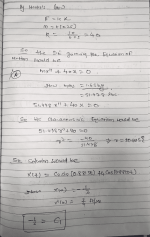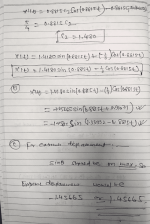Answer F ::
Pre-disassembly check
1. Filler plug
2. Gasket
3. Drain plug
4. Gasket
5. Electronic control coupling
6. Washer
7. Dynamic damper
8.Differential cover assembly
9. Vent plug
Answer E::
Words: Accelerating, Float, Gear, Noise, Tooth, Vehicle
Crown wheel and pinion noise originates from poor tooth contact and may be noticed on drive, overdrive or float. It can be more pronounced on one of these than on the others. Drive noise is most pronounced when accelerating, as the gear teeth are under load. The bearings are also under load so that any lack of preload will allow the gear teeth to change their area of contact. Noise on overdrive occurs as the vehicle_ decelerates from medium speeds, while float noise_ occurs under light cruising conditions
Answer D
What Are The Symptoms of a Bad Rear Differential?
Rear differentials give out noticeable symptoms once they start wearing out or getting damaged. Usually once your differential goes bad you might experience any of the following:
Difficulty in handling
As the differential is the element which helps handle your vehicle in a turn, once it starts to wear out, precision is not something that will be on your side anymore. The wheels will no be able to readjust their speeds making the handling of your vehicle quite unpredictable and can lead to an accident. It would be advisable to get your car to a mechanic as soon as you sense an issue with handling.
Tire damage
As you take corners the wheels and tires traveling at the same speed will lead to a premature wear of the inner tires or even damage because the speed will be significantly higher than what the inner threads were designed to sustain.
Vibrations
Significant wear and tear done to the universal joints of your differential lead to vibration in the drive shaft. This vibration can be felt more accentuated when you accelerate your vehicle and can lead to even stronger vibrations if differential fluid leak appears. These are early warning signs that the differential needs checking as soon as possible.
Whining Noises
These are the most common and appear due to lack of lubrication over internal components of the differential. This lack of lubrication can appear thanks to leaking fluids for example and will inevitably lead to whining noises when that happens.
Diagnosing Rear Differential Noise
There are various situations which can create rear differential noise. For example, howling of gears is a sure sign of wearing. If you notice that the howling noise only occurs during deceleration, then it is a good indicator that the pinion-bearing preload has loosened.
Howling under acceleration at various speeds, however, indicates that the gears are already worn out or are out of alignment or depth with each other. If rear differential noise occurs while accelerating the car only at a certain speed, it is likely because the gears have become worn due to overloading and lubrication failure. If your gears are newly installed and still create a howling noise, double-check its preload and make sure that the teeth are properly aligned.
Rumbling and whirring noises at speed over 20 mph, moreover, can be the result of worn carrier bearings. For vehicles with C-clip axles, the rear differential noise may change at different turns. Generally, worn out pinion bearings can create whirring noises at various speeds, be it may during deceleration and/or acceleration. If the pinion bearings are the problem, they create more of a whirring noise than a rumble because it turns several times faster than the carrier assembly. Regular clunking every few feet can also be an indicator of a broken pinion gear and/or chipped and damaged ring gear.
Overly worn out bearings tend to make a howling noise when they do not properly support the gears. Rumbling while turning, on the other hand, is a sign of bad wheel bearings. Clunking and banging noises on the corners can be due to lack of sufficient posi-traction lubrication, broken spider gears, or worn posi-traction or limited-slip clutches. Broken spider gears, moreover, can also immobilize the differential and create a loud, crunching sound during final departure. If the rear differential noise is characterized by clunking every two or three feet, then there is a great chance that a broken ring gear is the problem with the section with the broken teeth banging or grinding as it tries to engage the pinion.
Having a chipped or missing high spot on a gear tooth sounds closely similar to a broken gear except that the rear differential noise only happens while accelerating or decelerating. This is because the problem is just present on one side of the offending tooth. This rear differential noise is described as a heavy clicking type of sound which occurs every eight feet or so. If the pinion is the one that has a high spot, the noise occurs every two or three feet and is much more pronounced because of its higher frequency.







